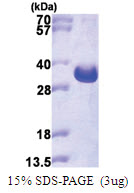LAT (28-233, His-tag) Human Protein
Other products for "LAT"
Specifications
| Product Data | |
| Species | Human |
| Expression Host | E. coli |
| Expression cDNA Clone or AA Sequence |
MGSSHHHHHH SSGLVPRGSH MHCHRLPGSY DSTSSDSLYP RGIQFKRPHT VAPWPPAYPP VTSYPPLSQP DLLPIPRSPQ PLGGSHRTPS SRRDSDGANS VASYENEEPA CEDADEDEDD YHNPGYLVVL PDSTPATSTA APSAPALSTP GIRDSAFSME SIDDYVNVPE SGESAEASLD GSREYVNVSQ ELHPGAAKTE PAALSSQEAE EVEEEGAPDY ENLQELN
|
| Tag | His-tag |
| Predicted MW | 24.4 kDa |
| Concentration | lot specific |
| Purity | >95% by SDS - PAGE |
| Buffer | Presentation State: Purified State: Liquid purified protein Buffer System: 20 mM Tris-HCl buffer(pH 8.0) containing 1mM DTT |
| Bioactivity | Specific: 1. Prepare a 200ul reaction mix into a suitable container: The final concentrations are 10mM Tris (pH7.5), 50mM NaCl, 2mM DTT, 1mM MnCl2, 10mM pNPP. 2. Pre-warm reaction mix in heat block at 37C. 3. Add recombinant DUSP3 protein solution with various concentrations (1ug, 2ug, 3ug) in 200ul reaction buffer. 4. Mix by inversion and incubate at 37C for 10minutes. 5. Stop the reaction by adding the 800ul of 0.1N NaOH and record the absorbance at 405nm. |
| Preparation | Liquid purified protein |
| Protein Description | Recombinant human LAT protein, fused to His-tag at N-terminus, was expressed in E.coli and purified by using conventional chromatography techniques. |
| Storage | Store undiluted at 2-8°C for one week or (in aliquots) at -20°C to -80°C for longer. Avoid repeated freezing and thawing. |
| Stability | Shelf life: one year from despatch. |
| Reference Data | |
| RefSeq | NP_001014987 |
| Locus ID | 27040 |
| UniProt ID | O43561 |
| Cytogenetics | 16p11.2 |
| Synonyms | IMD52; LAT1; pp36 |
| Summary | The protein encoded by this gene is phosphorylated by ZAP-70/Syk protein tyrosine kinases following activation of the T-cell antigen receptor (TCR) signal transduction pathway. This transmembrane protein localizes to lipid rafts and acts as a docking site for SH2 domain-containing proteins. Upon phosphorylation, this protein recruits multiple adaptor proteins and downstream signaling molecules into multimolecular signaling complexes located near the site of TCR engagement. Alternative splicing results in multiple transcript variants encoding different isoforms. [provided by RefSeq, Jul 2008] |
| Protein Families | Druggable Genome, Transmembrane |
| Protein Pathways | Fc epsilon RI signaling pathway, Fc gamma R-mediated phagocytosis, Natural killer cell mediated cytotoxicity, T cell receptor signaling pathway |
Documents
| FAQs |
Resources
Recombinant Protein Resources |
{0} Product Review(s)
0 Product Review(s)
Submit review
Be the first one to submit a review
Product Citations
*Delivery time may vary from web posted schedule. Occasional delays may occur due to unforeseen
complexities in the preparation of your product. International customers may expect an additional 1-2 weeks
in shipping.






























































































































































































































































 Germany
Germany
 Japan
Japan
 United Kingdom
United Kingdom
 China
China
